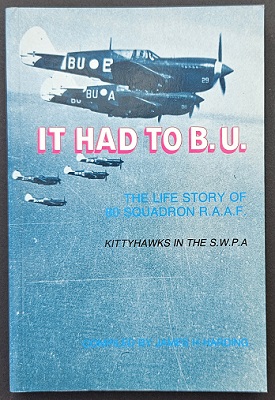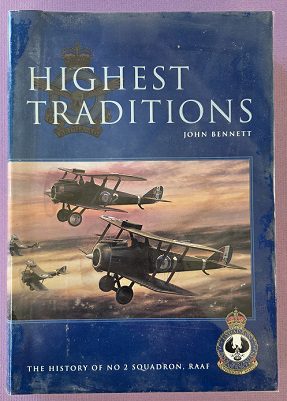Description
Title: It Had to B.U. – The Life Story of 80 Squadron R.A.A.F – Kitty Hawks in the S.W.P.A.
Author: Harding, James
Condition: Near Mint Plus.
Edition: 1st Edition
Publication Date: 1996
ISBN: 0959279350
Cover: Soft Cover without Dust Jacket – 215 pages
Comments: The story of No. 80 Squadron was a Royal Australian Air Force (RAAF) fighter squadron of World War II. The squadron was formed in September 1943 and was disbanded in July 1946 after seeing action in the South West Pacific Theatre of the war.
No. 80 Squadron was formed at Townsville, Queensland on 10 September 1943 and was equipped with P-40 Kittyhawk fighter aircraft. It moved to Aitkenvale on 9 October and commenced flight training.[1] On 13 November it became part of RAAF’s main mobile unit, No. 10 Operational Group, upon its formation. This group’s main role was to support the rapid advance of Allied units along the north coast of New Guinea. Once its training was completed the squadron moved again to Nadzab in New Guinea on 24 February 1944.
The squadron flew its first combat sorties two days after arriving in New Guinea. Its initial operations included patrols around Nadzab, escorting Allied bombers and ground attack missions against Japanese forces in and around Alexishafen and Madang. The squadron moved to Cape Gloucester, New Britain on 21 March to escort convoys and conduct armed reconnaissance patrols. It moved again on 29 April to Tadji on the New Guinea mainland where it flew patrols to protect the Allied landing at Hollandia. The squadron moved to Hollandia after it was secured, arriving there on 15 May.
No. 80 Squadron continued to support Allied amphibious operations between May and July 1944. In May it covered the invasions Wakde and Biak from its base at Hollandia. This included attacking targets near the beachhead at Wakde while US troops landed. The squadron moved twice in July, arriving at Biak on 1 July and Noemfoor on 22 July. From its base at Noemfoor, No. 80 Squadron conducted ground attack operations over western New Guinea and the eastern islands of the Netherlands East Indies. These operations included attacks on Japanese watercraft and sawmills around Kokas Island and sweeps over the Maluku Islands in October.
No. 10 Group, of which No. 80 Squadron was still part, was redesignated the First Tactical Air Force on 25 October 1944. On 15 January 1945, four of No. 80 Squadron’s pilots were ferrying Kittyhawks from Noemfoor to Morotai when they missed their destination and had to land on the Japanese-held Talaud Islands, where they were captured and executed. The unit completed its move to Morotai on 21 January, where it continued to operate over the Maluku Islands. The shortage of worthwhile targets in this area caused morale to decline in No. 80 Squadron and other RAAF units in the area from the end of 1944.
No. 80 Squadron was taken off operational status on 11 April 1945 to prepare for the Borneo Campaign. Later that month its commander, Squadron Leader John Waddy, participated in the so-called “Morotai Mutiny” as a protest against what he and seven other senior pilots saw as the misuse of the First Tactical Air Force in unimportant operations. While No. 80 Squadron’s ground crew landed at Tarakan in early May, delays with repairing the island’s airfield meant that the squadron’s aircraft were unable to move forward until 22 July. The limited flying opportunities for the squadron’s pilots in this period further reduced their morale. Once established at Tarakan, No. 80 Squadron flew close air support operations during the Battle of Balikpapan, but found few worthwhile targets.
Following the Japanese surrender No. 80 Squadron flew reconnaissance patrols over Japanese-occupied areas. The amount of flying was limited from September, however. In late 1945 the squadron’s personnel embarked aboard the British aircraft carrier HMS Glory which carried them to Sydney via Manus Island. Glory arrived at Sydney on 12 December 1945 and the members of the squadron from New South Wales proceeded to Deniliquin and the remainder were sent on leave. No. 80 Squadron’s strength was rapidly decreased, and it comprised only six personnel by 31 December. The last personnel left the unit on 9 May 1946 and it was disbanded on 11 July that year.
Includes nominal roll by pilots, officers and airmen. Also includes awards and the aircraft by serial number





